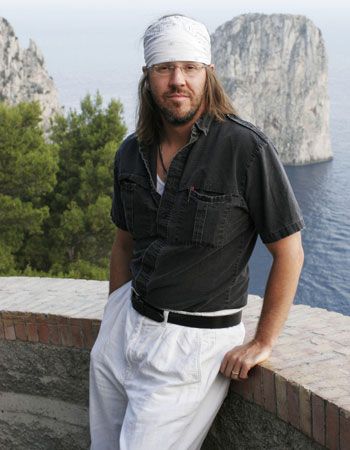Massive Tomes: 10 of the World’s Longest Novels
- Related Topics:
- novel
If you’re a book lover, you’ve probably been asked the eternal bookworm’s question: If you were stranded on a desert island, which book would you want by your side? Would you want a beach read to peruse as you sit on the sand and scan the horizon for rescue? Or a beginner’s guide to survival skills? Maybe you’d pick a classic massive tome, something to savor with all that extra time on your hands. The last option brings to mind another question: What is the longest novel ever published? Here’s a list of some of the world’s most imposing literary doorstops.
In Search of Lost Time by Marcel Proust
According to the Guinness Book of World Records, this seven-part work by French author Marcel Proust is the longest novel, totaling 9,609,000 characters, including spaces (or nearly 1,300,000 words). Published as À la recherche du temps perdu from 1913 to 1927, In Search of Lost Time is the story of Proust’s own life, told as an allegorical search for truth. Its writing was sparked by Proust’s sudden recall of a childhood memory when he tasted a rusk (a twice-baked bread, which in his novel became a madeleine) dipped in tea. The novel is also known in English as Remembrance of Things Past.
In the Realms of the Unreal by Henry Darger
The full title of this highly unusual magnum opus by 20th-century American outsider artist Henry Darger is The Story of the Vivian Girls, in What Is Known as the Realms of the Unreal, of the Glandeco-Angelinnian War Storm, Caused by the Child Slave Rebellion. More than 15,000 pages long, the story follows the Vivian Girls of the fictional Roman Catholic nation Abbieannia, who attempt to rescue kidnapped children enslaved by the atheistic and villainous Glandelinians. Pitting heroic children against evil, abusive adults, the tale is loosely based on events from the American Civil War. Darger first wrote the story in longhand and later typed it and added illustrations.
A Suitable Boy by Vikram Seth
Published in 1993, Indian writer Vikram Seth’s epic novel A Suitable Boy immediately drew comparisons to lengthy works by other authors on this list, including Proust and Leo Tolstoy. Already a highly regarded poet, Seth turned to prose to depict the relations between four families in post-partition India (after 1947), all crafted into a compelling narrative. Spanning more than 1,300 pages (and nearly 600,000 words), A Suitable Boy is touted as one of the longest English-language novels published as a single-volume work.
Dream of the Red Chamber by Cao Zhan
Considered to be the greatest of all Chinese novels and among the greatest in world literature, Cao Zhan’s Hongloumeng first appeared in manuscript form in the mid-18th century. The novel was published in a complete version of 120 chapters in 1791, nearly 30 years after the author’s death. It was published in English in 1929 as Dream of the Red Chamber. A more complete translation is the five-volume The Story of the Stone (1973–86). A partly autobiographical work, it describes in lingering detail the decline of the powerful Jia family and the ill-fated love between Baoyu and his cousin Lin Daiyu.
The Thousand and One Nights
So it’s not technically a novel but a collection of stories set within a frame story. Regardless, The Thousand and One Nights (also known in English as The Arabian Nights) certainly has enough tales to keep any island castaway occupied for some time. Featuring tales from India, Iran, Iraq, Egypt, Turkey, and possibly Greece, the collection is framed by the vengeful King Shahryar’s plan to marry a new woman each day, spend the night with her, and kill her in the morning, until no more candidates can be found. This bloody scheme continues until he marries the resourceful Shahrazad (Scheherazade), who averts her execution by beguiling the king with a different story each night. An early assemblage of the tales, undertaken by Abū ʿAbd Allāh ibn ʿAbdūs al-Jahshiyārī, featured only 480 stories by the time he died in 942. Others were added over time to reach the titular one-thousand—including those of Aladdin, Ali Baba, and Sindbad the Sailor.
Atlas Shrugged by Ayn Rand
Russian-born American author Ayn Rand followed up her hefty 700-plus-page novel The Fountainhead (1943) with this even heftier tome, considered by many fans to be her masterpiece. Published in 1957, Atlas Shrugged is a roughly 1,200-page exposition of Rand’s personal philosophy, known as objectivism, in fictional form. The book was attacked by critics from across the political spectrum for its perceived immorality and misanthropy and its overt hostility to religion (Rand was an atheist), but it was an instant best seller.
Les Misérables by Victor Hugo
Before it was a smash musical, and before it was a movie (or, more accurately, several movies), Les Misérables (1862) was French author Victor Hugo’s absorbing indictment of social injustice. He began working on it after the tragic death of his daughter in 1843, then put it aside for some time before completing it. Set among the vast panorama of Parisian society and its underworld, the novel follows the fortunes of the convict Jean Valjean, a victim of society who has been imprisoned for 19 years for stealing a loaf of bread. About 1,500 pages long, Les Misérables was an instant success and was quickly translated into several languages.
War and Peace by Leo Tolstoy
Like Les Misérables, Russian novelist Leo Tolstoy’s War and Peace, published as Voyna i mir in 1865–69, is an engrossing 19th-century read with a sweeping story that dives deep into the society it depicts. The book begins in St. Petersburg in 1805 and contains three kinds of material: a historical account of the Napoleonic Wars, the biographies of the novel’s fictional characters, and a set of essays about the philosophy of history. War and Peace is generally regarded as a masterwork of Russian literature and one of the world’s greatest novels. It is certainly one of the longest, with a word count totaling to over half a million.
Miss MacIntosh, My Darling by Marguerite Young
American poet and novelist Marguerite Young spent 18 years writing this 1,200-page novel of illusion and reality, Miss MacIntosh, My Darling (1965). The story centers on Vera Cartwheel, a woman who rejects her mother’s opium-induced vagueness and searches for her long-lost nursemaid, Miss MacIntosh, who represents common sense and reality. The book was inspired by Young’s experience working her way through graduate school (the University of Chicago) by reading Shakespeare out loud to a wealthy socialite and patron of the arts who was an opium user.
Infinite Jest by David Foster Wallace
A novel for lovers of footnotes as much as epic storytelling, Infinite Jest (1996) established American writer David Foster Wallace as one of the premier voices of satirical, postmodern fiction. His second novel, the multilayered Infinite Jest features a cast of characters that range from recovering alcoholics and foreign statesmen to residents of a halfway house and high-school tennis stars. It takes place in a futuristic world during calendar years that have been named by companies that purchased the rights to promote their products. Oh, and nearly a hundred of its thousand-plus pages consist of 388 detailed (and very funny) footnotes.

























